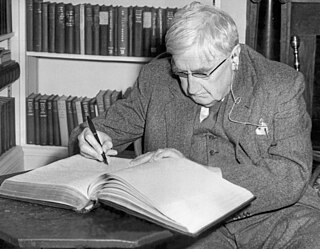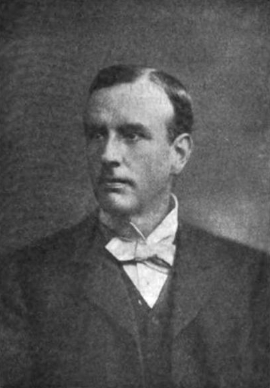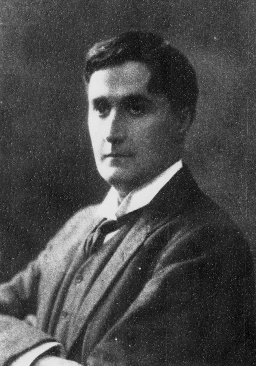Related Research Articles

Ralph Vaughan Williams was an English composer. His works include operas, ballets, chamber music, secular and religious vocal pieces and orchestral compositions including nine symphonies, written over sixty years. Strongly influenced by Tudor music and English folk-song, his output marked a decisive break in British music from its German-dominated style of the 19th century.

The Mass is a form of sacred musical composition that sets the invariable portions of the Christian Eucharistic liturgy, known as the Mass.
Ralph Vaughan Williams wrote his Symphony No. 5 in D major between 1938 and 1943. In style it represents a shift away from the violent dissonance of his Fourth Symphony, and a return to the gentler style of the earlier Pastoral Symphony.

Edmund Rubbra was a British composer. He composed both instrumental and vocal works for soloists, chamber groups and full choruses and orchestras. He was greatly esteemed by fellow musicians and was at the peak of his fame in the mid-20th century. The best known of his pieces are his eleven symphonies. Although he was active at a time when many people wrote twelve-tone music, he decided not to write in this idiom; instead, he devised his own distinctive style. His later works were not as popular with the concert-going public as his previous ones had been, although he never lost the respect of his colleagues. Therefore, his output as a whole is less celebrated today than would have been expected from its early popularity. He was the brother of the engineer Arthur Rubbra.

Fantasia on a Theme by Thomas Tallis, also known as the Tallis Fantasia, is a one-movement work for string orchestra by Ralph Vaughan Williams. The theme is by the 16th-century English composer Thomas Tallis. The Fantasia was first performed at Gloucester Cathedral as part of the 1910 Three Choirs Festival, and has entered the orchestral repertoire, with frequent concert performances and recordings by conductors and orchestras of various countries.
Serenade to Music is an orchestral concert work completed in 1938 by English composer Ralph Vaughan Williams, written as a tribute to conductor Sir Henry Wood. It features an orchestra and 16 vocal soloists, with lyrics adapted from the discussion about music and the music of the spheres from Act V, Scene I from the play The Merchant of Venice by William Shakespeare. Vaughan Williams later arranged the piece into versions for chorus and orchestra and solo violin and orchestra.

Robin Humphrey Milford was an English composer and music teacher.
Herbert Whitton Sumsion was an English musician who was organist of Gloucester Cathedral from 1928 to 1967. Through his leadership role with the Three Choirs Festival, Sumsion maintained close associations with major figures in England's 20th-century musical renaissance, including Edward Elgar, Herbert Howells, Gerald Finzi, and Ralph Vaughan Williams. Although Sumsion is known primarily as a cathedral musician, his professional career spanned more than 60 years and encompassed composing, conducting, performing, accompanying, and teaching. His compositions include works for choir and organ, as well as lesser-known chamber and orchestral works.

Ralph Vaughan Williams's Symphony No. 8 in D minor was composed between 1953 and 1955. Sir John Barbirolli, its dedicatee, conducted the Hallé Orchestra in the premiere at the Kings Hall in Manchester, on 2 May 1956. It is the shortest of the composer's nine symphonies, and is mostly buoyant and optimistic in tone.

Dona nobis pacem is a cantata written by Ralph Vaughan Williams in 1936 and first performed on 2 October of that year. The work was commissioned to mark the centenary of the Huddersfield Choral Society. Vaughan Williams produced his plea for peace by referring to recent wars during the growing fears of a new one. His texts were taken from the Mass, three poems by Walt Whitman, a political speech, and sections of the Bible. A.V. Butcher has analysed Vaughan Williams' use of the Whitman poems in this composition.
Patrick Arthur Sheldon Hadley was a British composer.

Alan Gray was an English organist and composer.
William Brocklesby Wordsworth was an English composer. His works, which number over 100, were tonal and romantic in style in the widest sense and include eight symphonies and six string quartets.
Fantasia Concertante on a Theme of Corelli, also known as the Corelli Fantasia, is a work for string orchestra by the British composer Michael Tippett. It was commissioned by the 1953 Edinburgh Festival to commemorate the 300th anniversary of the birth of the Italian composer Arcangelo Corelli, and given its first performance on 29 August 1953, in the Usher Hall, by the BBC Symphony Orchestra conducted by Tippett.
A Cambridge Mass is a choral work in G major by Ralph Vaughan Williams written between 1898 and 1899 as part of his studies in Cambridge for his Doctorate of Music. It is one of two large scale choral works with orchestral accompaniment by Vaughan Williams surviving from this period, the other being a cantata setting of Swinburne's poem The Garden of Proserpine.

O clap your hands is a motet by Ralph Vaughan Williams. He composed the anthem, a setting of verses from Psalm 47, in 1920 for a four-part choir, organ, brass, and percussion. He later also made versions for orchestra and for organ. The motet was often recorded.

The Lark Ascending is a short, single-movement work by the English composer Ralph Vaughan Williams, inspired by the 1881 poem of the same name by the English writer George Meredith. It was originally for violin and piano, completed in 1914, but not performed until 1920. The composer reworked it for solo violin and orchestra after the First World War. This version, in which the work is chiefly known, was first performed in 1921. It is subtitled "A Romance", a term that Vaughan Williams favoured for contemplative slow music.

The Carnegie Collection of British Music was founded in 1917 by the Carnegie Trust to encourage the publication of large scale British musical works. Composers were asked to submit their manuscripts to an anonymous panel. On the panel at various times were Hugh Allen, Granville Bantock, Arnold Bax, Dan Godfrey, Henry Hadow and Donald Tovey. Up to six works per year were chosen for an award – publication at the expense of the Trust, in conjunction with music publishers Stainer & Bell. Unfortunately the war delayed things for the earliest prizewinners. The first to be published was the Piano Quartet in A minor by Herbert Howells.. By the end of 1920 some 13 works were available. 30 were out by the end of 1922, and when the scheme finally closed in 1928 some 60 substantial works that might not otherwise have seen the light of day had been issued under the Carnegie Collection of British Music imprint.
References
- ↑ Carwood, Andrew. Notes to Hyperion CD A67503 (2005)
- ↑ Meyer, Stephen (ed.) The Oxford Handbook of Music and Medievalism (2020), p. 336
- ↑ Notes to Nimbus CD NI5083 (2012)
- ↑ Ralph Vaughan Williams, Earth’s Wide Bounds, Albion CD ALBCD051 (2022), reviewed at MusicWeb International